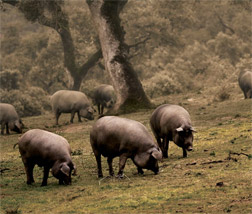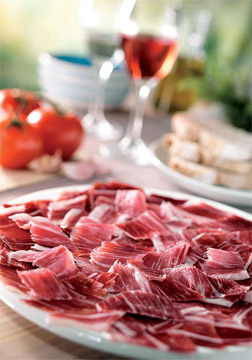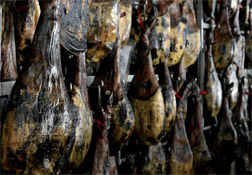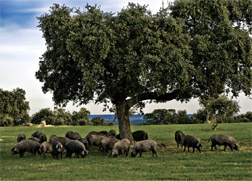Iberian ham, a time-honoured industryAgricultural
José Vilches
Managing Director
NAVIDUL
Madrid - España
Introduction







Ham is a product rich in symbolic significance that embodies the very best of Spain’s culinary tradition. It is a true totem for the country and our most wholesome foodstuff. Highly nutritious, it is seen as a Spanish icon around the world.
Ham is also at the centre of the largest meat processing market in Spain, with an annual production of some 47 million units and sales of EUR 1.88 billion, an industry encompassing hundreds of producers.
Most ham is consumed in the household with 77.2% of the total, while bars and restaurants take up 22.8%. Ham is found in 90% of Spanish households, making it one of the most commonly consumed edibles in the country.
Ham is divided into two main categories under Spanish law:
- Serrano/Dry cured. This category represents 79% of the total production and 66% of sales. Derived from white pigs, serrano ham is more common and affordable, and is therefore used in day-to-day consumption. It is regulated by an EU law that requires it to be cured on the bone for a minimum of seven months.
- Iberian. This category represents 21% of total ham production and 34% of sales in the Spanish market, amounting to EUR 696 million. Iberian ham is derived from a breed of pig that is exclusively found in the Iberian Peninsula. It is a more primitive, less productive animal that requires a longer curing period (a minimum of 24 months) on account of its higher fat content, including the intramuscular fat that gives it its distinctively delicious taste.
The Iberian pig
History of the Iberian pig
Iberian pigs are the result of inter-breeding with different varieties of wild boar. With only a small population (fewer than two million individuals in 2013), this indigenous breed is found only in the Iberian Peninsula. The dehesa, an ecosystem of pastureland dotted with holm oaks, is the perfect environment for these pigs, where they are raised following a special rearing and feeding regime.
Iberian pigs’ tendency to store fat within their muscles makes them unique and gives the products derived from them an outstanding taste, texture and aroma. Most celebrated among these products is Iberian ham. The first known hams go back to the time of the Roman empire. A fossilised ham estimated to be 2,000 years old was found in Tarragona in north-eastern Spain, the site of the ancient city of Tarraco.
Strains, lifecycle and feeding
The Iberian pig breed actually comprises several strains, which are grouped into two main varieties by their skin colour: black and reddish.
Iberian sows have fewer and smaller litters than other breeds. The gestation period is a curious three months, three weeks and three days. At birth, the piglets weigh about one kilo. Slaughtering takes place when the pigs are at least 10 months old, and there are specific names for pigs of different ages: tostón, lechón, marrano, primal and gordo, from the youngest to the oldest.
Iberian pigs’ diet goes through three stages: a lactation period where the piglet feeds on the mother’s milk, a growing period where cereal feed is used, and lastly a fattening period, which results in an acorn-fed (bellota) Iberian ham if the pig is allowed to roam the dehesa freely feeding on acorns and grass, or else a grain-fed (cebo) Iberian ham if the pig is given grain feed only.
Iberian ham
Types of Iberian ham
Iberian pigs’ tendency to store fat within their muscles makes them unique and gives the products derived from them an outstanding taste, texture and aroma
Ham (jamón in Spanish) is the cured hind leg of the pig. The fore leg is called shoulder (paleta). Under the new Iberian ham regulations (effective since January 2014), there are four main categories of Iberian ham according to the pig’s diet and handling. It is worth noting, however, that this classification will not apply to products sold on the market at least until the beginning of 2016:
- 100% Iberian acorn-fed ham (Jamón de bellota 100% ibérico). Identified by a black tag. Derived from 100% pure Iberian breed pigs fed strictly on acorns they find on the grazing land during the montanera, the period from October to March when acorns fall from the oaks. During that period, the pigs gain at least 46 kg over a minimum of 60 days. This category represents only 5.3% of all Iberian pigs slaughtered (see Table 1).
- Acorn-fed ham (Jamón de Bellota). Derived from 50% or 75% pure Iberian breed pigs (mother registered in the official pedigree book). Identified by a red tag. The same strictly-acorn feeding as the previous category, but with a cross-bred pig, between a pure-bred Iberian female and a Duroc male. This category represents 13% of the available total.
- Iberian grain-fed ham (Jamón de cebo ibérico). Identified by a white tag. Derived from Iberian pigs fed on a diet of natural feed made with selected cereals. This is the most common category, representing about 80% of the total.
- Free-range grain-fed Iberian hams (Jamón de cebo de campo ibérico), a subcategory of the grain-fed class, are derived from pigs fed on grain and reared in farms with a low density of individuals per hectare. In 2013 only 35,000 pigs were assigned this grade (2% of the total).
| 2012 | 2013 | Variation (%) | % of total | |
|---|---|---|---|---|
| Acorn-fed 100% Iberian | 105,065 | 107,232 | 2.06% | 5.38% |
| Acorn-fed Iberian | 306,226 | 258,609 | -15.55% | 12.98% |
| Grain-fed free-range Iberian | 33,219 | 35,409 | 6.59% | 1.78% |
| Grain-fed Iberian | 1,875,190 | 1,591,730 | -15.12% | 79.87% |
| Total | 2,319,700 | 1,992,980 | -14.08% | 100% |
As a general rule, the retail price of acorn-fed ham is double the price of grain-fed ham, and this is in turn double the price of serrano ham.
Production
Iberian ham curing is a unique process lasting more than 24 months. The temperature is gradually raised and the humidity reduced so that only sea salt is needed to extract the water contained in the meat
Iberian hams undergo a unique curing process lasting at least 24 months. The temperature is gradually raised and the humidity reduced so that only sea salt is needed to extract the water contained in the meat. Today, the great majority of producers replicate a process that has been known and used for centuries:
- Dry salting:
Once the hams have been prepared and sorted by size, they are covered in salt for approximately one day per kilo of weight, at winter-like temperature and humidity. Next, they are rinsed with cold water to remove excess salt from the surface. - Post-salting:
The aim is to make hams firm as the salt spreads evenly throughout their interior. This stage takes place in controlled chambers where the temperature is set at approximately 4ºC and humidity is 10% lower than in the previous stage. - Drying:
The hams are transferred to drying kilns, where the temperature is higher and the humidity is lower. In these spring-like conditions, their colour stabilises and the characteristically Iberian taste and aroma develop. - Stoving:
This last part of the drying stage takes place in summer-like conditions, with the hams kept at temperatures in the region of 25ºC for about three months. - Cellar
Maturation is the longest stage of all. Kept in a cellar, hams slowly age and acquire their distinctive bouquet.

Nutritional value
Iberian ham’s nutritional properties, particularly the acorn-fed variety, make it a source of health and well-being and a key supplement to the Mediterranean diet.
As much as 62% of its fat content is mono-unsaturated fatty acids and oleic acid, which help to raise HDL levels in the blood and reduce C-LDL.
Rich in vitamins and minerals, it has a high content of vitamin E -the «youth-and-beauty» vitamin- as well as vitamins B1, B6 and B12, and folic acid, all of which are highly beneficial for the nervous system and for the brain in particular. Minerals including iron, copper and phosphorous, proteins in abundance, and other oligo-elements that help prevent anaemia and contribute to muscle and bone development.
100g of ham only contain 190 calories - less than any other cured meat.
Enjoying the tastes of Iberian ham’s
Iberian ham is considered one of the four most exquisite delicacies in western culture, alongside caviar, foie gras and truffles.
The meat is dark red, almost purple, though the different cuts vary in hue and taste: mace, thickflank, end and knuckle each have their own shades and nuances
Interspersed white fat with yellowish tinges gives Iberian ham its characteristic marbled appearance. The meat is dark red, almost purple, though the different cuts vary in hue and taste: mace, thickflank, end and knuckle each have their own shades and nuances.
More than 170 volatile substances make up its unmistakably intense aroma, touched by hints of mushrooms, dried fruits and caramel.
The taste of acorn-fed Iberian ham is predominantly sweet, with touches of salt and a faintly bitter aftertaste. The flavour is further enhanced by the lusciously juicy texture that only Iberian pork’s marbled fat can provide.
The dehesa
The dehesa is a unique ecosystem where the Mediterranean forest is farmed in the best possible way. The trees, mainly of the Quercus species, include holm oak, cork oak and gall oak. These varieties produce acorns that ripen in the autumn and feed the pigs in the winter. Traditional rearing of Iberian pigs has been instrumental for the conservation of the dehesa.
Almost half of the world’s total holm oak surface is in Spain - 1.6 million hectares, of which almost a million are in the southwestern region of Extremadura, and the rest in Andalusia, Castile-La Mancha and Castile-Leon.
Controlled designations of origin
Spain has four controlled designations of origin for Iberian pork products, while neighbouring Portugal has one. Their purpose is to protect and control the hams produced in the designated regions and ensure they meet certain distinctive specifications.
- The «Dehesa de Extremadura» designation of origin was established in 1990 and covers 85 villages. Its climate is continental with some Atlantic influence.
- The «Guijuelo» designation of origin was established in 1984. It covers 76 producers distributed across a number of villages in the area of Guijuelo. It has cold, dry winters and short, mild summers.
- «Jamón de Huelva» pigs are reared in the dehesas of Extremadura, Seville, Cordoba, Cadiz, Malaga and Huelva. The designation of origin covers 31 villages.
- «Los Pedroches» is a designation of origin covering more than 100 farms and 16 producers, all of them located in the region of the same name, the greatest part of which is in Cordoba province. The region has fairly cold winters and extremely warm summers.
- «Barrancos» is the only Portuguese designation of origin, covering Iberian ham produced in the Alentejo region. Home to one of the purest breeds of Iberian pigs in the Iberian Peninsula, its products are considered the best in that country.
The Spanish Iberian pork industry
Key figures
Spanish Iberian pig rearing and its associated industries are starting to emerge from a severe crisis that has caused far-reaching transformation.
Spain has four controlled designations of origin for Iberian pork products, while neighbouring Portugal has one. Their purpose is to protect and control the hams produced in the designated regions and ensure they meet certain distinctive specifications
The Iberian pig population has fallen by more than 50% since 2008, as have slaughtering (only two million heads were slaughtered in 2013, 80% of which were grain-fed) and industrial production of Iberian pork products.
The largest producing region is Castile-Leon, with 35% of the total -the vast majority in Salamanca province- followed by Extremadura, with 33% of the total. In recent years, intensive farming has begun to appear in other regions with no tradition of Iberian pig rearing, including Murcia and Catalonia.
Regarding sales, 4.8 million hams and 4.66 shoulders were sold in 2012, down 4% on aggregate. Home consumption has dropped 8.3% since 2009 according to the MAGRAMA1, despite significant reductions in retail prices, which producers have resorted to in a bid to reduce their stocks and obtain the cash flow needed to continue production in a market where finance is hard to come by.
1 MAGRAMA: Spanish Ministry for Agriculture, Food and the Environment
Industry trends
In the years of the economic boom, the Spanish Iberian ham industry attracted a host of new players. Some of them had made money in the property sector and invested in enlarging livestocks and building new abattoirs and curing facilities.
This expansion of the industry’s capacity meant that, when the crisis slashed the natural demand of upmarket products such as Iberian ham, the market had excess stocks and capacity. Prices plummeted, the industry was unable to find the funding needed to feed its working capital requirements and became beset by financial problems. Leading firms closed down, went into insolvency, changed hands or sought deals to refinance their debt.
After years of drastic adjustment, the situation is reversing as many farms have shut down or reduced their pig stocks, leading to an already noticeable scarcity of raw material and sharp increases in the price of fresh produce, which in 2014 have begun to translate into rising retail prices.
Industrial producers will still have to face uncertainty for several years but diminished competition and downsized surviving businesses are opening up opportunities set to deliver returns on a par with those of the past.
The industry is thus becoming more concentrated in fewer players. This process favours companies with easier access to finance, wide market reach, reputed brands and, most importantly, diversified businesses that include prepared meat products from white pigs and other animal species such as turkey and chicken.
Similarly, farmers who have survived the crisis are now seeing the prices of pork and live pigs climb rapidly in the markets of Merida and Salamanca, offsetting the increase of previous years in the cost of cereals used as feed. This ensures the profitability of their businesses at least until the next change in cycle.
Excessive pig supply has given way to scarcity and rising prices in raw materials which, added to strong competition, is creating difficulties for producers. To be specific, fresh ham that was priced at 3.50 EUR/kg in 2012 was being sold at above 6.50 EUR/kg only a year later.
The supply and demand cycle of Iberian ham
Ham is the most important cut of Iberian pork and ultimately the reason for breeding Iberian pigs. It is exclusive to the Iberian Peninsula (there are no other markets for it in its fresh form), production cycles are longer than two years, and it cannot be used for other purposes (unlike white ham, which can also be boiled). The industry that produces it is highly atomised and scarcely regulated. For all these reasons, supply and demand never match up for very long, which creates a cycle that under normal circumstances lasts for seven years, permanently oscillating between oversupply and undersupply, with the selling price (which is prone to considerable variations) as the regulating factor.
Regulatory framework
The 2007 regulations, which have been in force until very recently, were an attempt to bring order into an industry where confusion had traditionally been the norm and where a few wily producers took advantage of consumers’ understandable unfamiliarity with the product.
After years of drastic adjustment, the situation is reversing as many farms have shut down or reduced their pig stocks, leading to an already noticeable scarcity of raw material and sharp increases in the price of fresh produce
Relaxed supervision prevented the 2007 regulations from being fully enforced. This, coupled with the ongoing transformation in the industry, prompted the Ministry for Agriculture (MAGRAMA) to introduce a new set of Quality Regulations in January 2014, following protracted negotiations with the different stakeholders.
Hammered out over several months marked by territorial wrangling and interest clashes, the new regulations simplify ham categories and are expected to improve compliance, prevent unfair competition and protect consumers and businesses that adhere to the law strictly and consistently, as we do.
Exports
The statistics available to us do not discriminate between the different types of cured ham, but we know that the vast majority of sales are serrano ham rather than Iberian ham, which is barely known or appreciated outside of Spain.
Spanish ham exports amounted to EUR 303 million, up 16.6%, and some 31,100 tons (16% of the total Spanish production). The leading destinations are in Europe: Germany with 8.579 tons (27% of the total), France (26%), Portugal (9.2%), Italy (4%) and Belgium (4%). Significant non-European importers include Mexico with 785 tons (3% of the total) and the US with 485 tons (mostly serrano).
References
- El Jamón. Elegirlo, cortarlo y saborearlo (Selecting, slicing and enjoying ham). Author: Juan Carlos Gómez Sierra Published by ANAYA, Oberón Práctico, Para Torpes collection. 2011
- El jamón (Ham). Editor: Paco Asensio. Texts: Cristina Montes Loft Publications. 2002.
- El cerdo Ibérico, la naturaleza, la dehesa (The Iberian pig, nature and the dehesa). Published by: Ministry of Agriculture, Fisheries and Food, General Technical Secretariat. 1997.



